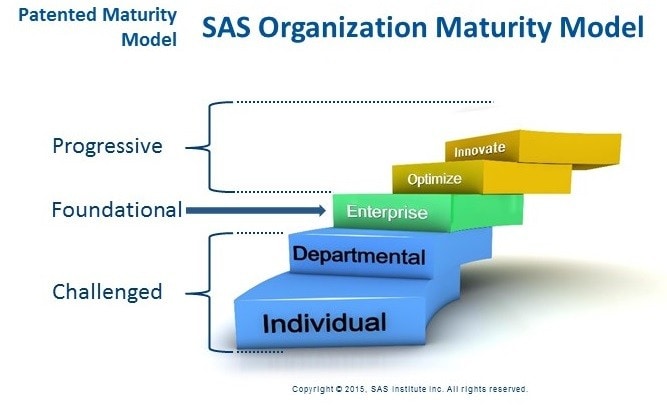Evolving your institutional insight
Where does your organization stand on its analytical maturity?
By Karen Stout, Ed.D., President and CEO, Achieving the Dream and Aiman Zeid, Head of Global Business Consulting and Organizational Transformational Services, SAS
Big data in education can give us deep insights into college applicants and students, their motivations and habits, which ones will struggle and why. However, what sounds like simple cause and effect (i.e., big data leads to better decisions) is actually a complex issue. And it starts with analytics.
Analytics combines science and technology to mine information, uncover hidden trends and forecast potential outcomes in a student’s journey through college. Analytics can pinpoint the right interventions to help identified students achieve their academic and career goals. It can reveal which institutional investments will deliver results at the best value, and how to become a high-performing college while keeping tuition affordable.
We are past the stage of justifying analytics to inform our decision-making process. Most colleges, like their counterparts in the private sector, have had a taste of how analytics, and the insight it produces, can improve the accuracy of our decisions – and validate our assumptions and strategies.
If it is done right.
It takes four pillars – people, processes, technology and culture – to drive meaningful use of information. Technology is just a piece of the puzzle.

All we need is technology, right?
Often the first reaction is to buy analytical and reporting tools to manage, mine and extract knowledge from the data already on hand. Unfortunately, institutions cannot buy their way out of an information jam with technology. Rather than focusing solely on the information platform and tools, institutions need to assess and develop four pillars in concert:
- People (skills and resources). Do we have enough skilled people in the right roles to support the institution’s information needs? Are they empowered to create and act on data-informed insights?
- Information processes and operating model. Are information processes fragmented at the individual or department level (think renegade spreadsheets), or are they aligned to institutional strategy and goals?
- Technical information infrastructure. Does the institution have the necessary data management, reporting and analytical capabilities to answer its most pressing questions?
- Organizational culture. Is there a culture that expects the use of data to support decisions? Will people use data to make decisions? Is information sharing the norm? Is there sufficient financial support for this effort?
Finding your starting point
Some public community college systems are far ahead of others in developing these pillars. Many leading institutions have created a sophisticated institutional research (IR) function that is well-integrated with IT and meets both internal needs for information and external accountability demands. These institutions have good data sharing among systems and campuses and a high degree of differentiation in roles between the system and the campus.
That is not the norm in higher education – yet. The Achieving the Dream network is working to change that. The mission of this national reform network is to improve college completion rates, especially for the most underprepared students. Data-informed decisions are central to that mission.
The investment is worth it. If the four pillars are lacking or out of alignment, the institution misses out on the full value of its technology investments. For example, information processes may be repeated each time a new question arises, which adds cost and delay. Multiple methods may be used, each drawing on different versions of the truth, which leads to inaccurate and inconsistent results. Ultimately, users then lose confidence in the data and fall back on educated guesses.
A systematic model to assess analytical maturity
In the books Information Revolution and Business Transformation, thought leaders at SAS defined the Information Evolution Model to articulate the various stages of maturity in how organizations manage and use data. Based on years of global consulting expertise, this model provides a framework to assess where you are today, the alignment (or misalignment) of the four pillars, landmarks at each level, and how to chart the evolution journey from there. It has guided successful transformations for organizations across industries and around the world.

The model defines five levels grouped into three categories:
Challenged
Level 1. At the individual level, individuals own and control data and use it to tackle day-to-day functional issues. The institution is in firefighting mode, project to project. There is little or no support or technology for a culture of evidence, and only spotty data and limited interest in analytics.
Level 2. At the departmental level, departments take control of their information and start to produce performance reports and metrics for their function. Still, systems are isolated into information silos and not well-aligned at the college level.
Foundational
Level 3. The enterprise-level institution integrates information from across functional areas into an institutionwide information environment with clear support from leadership. Reporting and analysis are effective and accurate, so people trust the data and use it to make decisions. The institution has a clear view of its internal information chain.
Progressive
Level 4. At the optimization level, quality data and advanced analytical capabilities are used to optimize outcomes across the institution – both in terms of operational efficiency and student success. The institution sees tangible improvements in key functions and metrics.
Level 5. Finally, at the innovation level, data supports deep and continuous renewal. There is a highly skilled IR/IE/IT team that focuses on new ways to achieve priorities. The college routinely reaps the benefits of enterprisewide analytics capability to find new ways to serve students, enhance success and manage operations.
Each level is a natural precursor to the next higher level; each higher level encompasses and exceeds all previous levels.
Where does your institution rank?
Most community colleges have evolved out of the risky and ad hoc Level 1 phase, with its information mavericks. Many higher education institutions are at Level 2. Most have made great strides in managing the data but have not advanced as far in analyzing that data and communicating the insights. Even in the enterprise world, most organizations have not fully achieved Level 3 status.
The Information Evolution Model helps colleges understand where they are today and how to structure their unique evolution journey from here.
Signs of a rise in culture of evidence
We are seeing sure signs of a rising culture of evidence. Achieving the Dream colleges are:
- Making investments in hiring new IR staff, buying new IT systems, forming data planning committees and improving professional staff data skills.
- Owning their stories and putting collective energy into improvement – converging around a consistent and intelligent methodology rather than arguing about the quality of the data or a specific metric.
- Establishing data governance and a philosophy of campuswide data stewardship rather than isolated data ownership.
- Engaging with the data through self-service business intelligence, data visualizations, mobile apps and dashboards to inform policy and practice.
Momentum is building. There is growing enthusiasm about the work on our campuses, and more people are asking the sorts of questions that spark new ideas.
In Good to Great and the Social Sectors, Jim Collins said it well: “In building a great institution there is no single defining action, no grand program, no one killer innovation, no solitary luck break, no miracle moment. Pushing with great effort – days, weeks and months of work, with almost imperceptible progress – you finally get the flywheel to inch forward. But you don’t stop. You keep pushing …”
Many of our Achieving the Dream colleges are now a full decade into this work. We’re seeing progress in developmental success rates, gateway course completion rates, persistence rates and, for many of you, a significant increase in the numbers of degrees, certificates and credentials conferred. The flywheel is in motion, and we’ll keep pushing.
Karen A. Stout became President and CEO of Achieving the Dream, Inc., on July 1, 2015. Dr. Stout is a nationally renowned scholar and academic leader in strategies for enhancing student success and completion, data informed decision making, accelerating and scaling innovation, and new approaches to community college fundraising.

Aiman Zeid is the author of Business Transformation: A Roadmap for Maximizing Organizational Insights and a SAS global consultant. He has more than a decade of experience helping organizations develop a sophisticated and successful approach to using information.

Read More
The Achieving the Dream article series:
- Data drives destiny
- A culture of evidence
- Evolving your institutional insights
- Lessons learned, looking forward
Get More Insights
Want more Insights from SAS? Subscribe to our Insights newsletter. Or check back often to get more insights on the topics you care about, including analytics, big data, data management, marketing, and risk & fraud.
